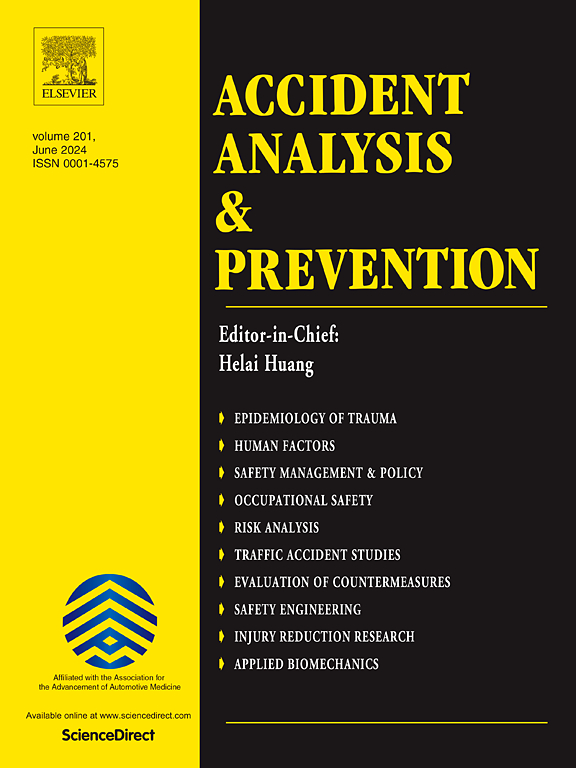利用可解释深度学习和不确定性量化建模无保护左转弯时的决策
IF 5.7
1区 工程技术
Q1 ERGONOMICS
引用次数: 0
摘要
不受保护的左转给司机带来了挑战,因为他们必须管理十字路口的潜在冲突,这需要一个不同于其他驾驶场景的决策过程。虽然许多研究在行为层面上模拟了人类在无保护的左转情况下的决策,但大多数研究忽视了影响驾驶行为的关键信息的可变性,很少探索决策的内在机制。本研究从决策不确定性的角度分析驾驶员在无保护左转场景下的决策过程,探讨不确定性与安全的关系。首先,引入冲突区域计算方法识别无保护左转交互事件;其次,结合Shapley加性解释,利用变压器模型识别驱动左转决策的关键变量。最后,利用Jensen-Shannon散度对决策不确定性进行量化。我们探讨了两种无保护的左转场景:左转弯让步和左转弯继续。实验结果表明:(1)左转弯车辆优先考虑等待时间、车型等静态变量,对迎面车辆优先考虑到达停车线时间、速度差等动态变量;(2)时间压力的增加导致驾驶员在关键决策阶段更加重视横向速度和偏航角;(3)更高的不确定性水平往往伴随着更长的协商过程和更短的入侵后时间,这可能增加不安全操作的可能性,如紧急制动。这些见解有助于为无人驾驶汽车在无保护的左转情况下导航提供决策框架。本文章由计算机程序翻译,如有差异,请以英文原文为准。
Modeling decision-making during unprotected left turns using interpretable deep learning and uncertainty quantification
Unprotected left turns present challenges to drivers, as they must manage potential conflicts at intersections, which requires a decision-making process different from that in other driving scenarios. While many studies have modeled human decision-making in unprotected left-turn situations at a behavioral level, most overlook the variability of key information that influences driving behavior and rarely explore the intrinsic mechanisms of decision-making. This study analyzes the decision-making process of drivers in unprotected left-turn scenarios from the perspective of decision uncertainty and explores the relationship between uncertainty and safety. First, a conflict area calculation method is introduced to identify unprotected left-turn interaction events. Next, a transformer model combined with Shapley Additive Explanations is used to identify the key variables driving left-turn decision-making. Finally, Jensen-Shannon divergence are employed to quantify decision-making uncertainty. We explore two types of unprotected left-turn scenarios: left-turn yielding and left-turn proceeding. The experimental results reveal that: (1) left-turning vehicles prioritize static variables, such as waiting time and vehicle type as key variables, while oncoming vehicles focus more on dynamic variables like time to the stop line and speed difference; (2) increased time pressure leads drivers to emphasize on lateral speed and yaw angles during critical decision phases; and (3) higher uncertainty levels are often accompanied by longer negotiation processes and shorter post-encroachment times, which can increase the likelihood of unsafe maneuvers, such as emergency braking. These insights are instrumental in informing decision-making frameworks for autonomous vehicles navigating unprotected left-turn scenarios.
求助全文
通过发布文献求助,成功后即可免费获取论文全文。
去求助
来源期刊

Accident; analysis and prevention
Multiple-
CiteScore
11.90
自引率
16.90%
发文量
264
审稿时长
48 days
期刊介绍:
Accident Analysis & Prevention provides wide coverage of the general areas relating to accidental injury and damage, including the pre-injury and immediate post-injury phases. Published papers deal with medical, legal, economic, educational, behavioral, theoretical or empirical aspects of transportation accidents, as well as with accidents at other sites. Selected topics within the scope of the Journal may include: studies of human, environmental and vehicular factors influencing the occurrence, type and severity of accidents and injury; the design, implementation and evaluation of countermeasures; biomechanics of impact and human tolerance limits to injury; modelling and statistical analysis of accident data; policy, planning and decision-making in safety.
 求助内容:
求助内容: 应助结果提醒方式:
应助结果提醒方式:


